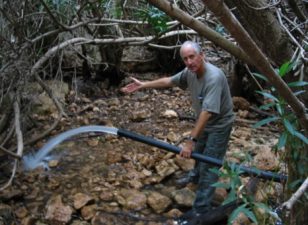
Libya invests $20 billion in massive man made river to irrigate the thirsty nation. It took new roads to build, and a vast amount of resources. So far investment interest from the US has been poor.
BENGHAZI, Libya — From the sky, Libya’s Grand Omar Mukhtar Reservoir resembles a shimmering blue circle nestled in the desert sands. At ground level, the artificial lake is so vast that it’s impossible to photograph the whole structure with anything but a fisheye lens.
In fact, it takes a good 10 minutes to drive around the reservoir’s 3.5-kilometer perimeter gravel road. Holding 24 million cubic meters of water, Omar Mukhtar is the second-largest reservoir in the world — and a crucial element in Libya’s ambitious, $20 billion Great Man-Made River (GMMR) project.
“Before the implementation of the GMMR, the Libyan people were desperate for a few drops of water throughout the year,” says a government brochure describing the project. “Now, with a daily flow of over six million cubic meters, there is enough water to supply each citizen in the Great Jamahiriya with over 1,000 liters per day. In addition, 135,000 hectares of land will be freed from drought.”
The GMMR ranks easily as the largest and most expensive irrigation project in world history. Conceived in the late 1960s, its mission is simple: to pump water from Libya’s vast, underground Nubian Sandstone Aquifer System in the south to populated coastal areas in the north where most of the country’s six million inhabitants live and work.
Phase I of the GMMR, with a price tag of $5.5 billion, commenced in 1984 and since 1991 brings two million cubic meters of water daily from the immense Sarir and Tazerbo basins 1,200 kilometers north to the coastal strip between Sirte and Benghazi.
Phase II, costing just over $8 billion, carries 2.5 million cubic meters per day from the Murzuq Basin, feeding the cities between Sirte and Tripoli. Libya’s capital received its first supplies of GMMR water in September 1996.
Following the completion of Phase II, a third phase — estimated to cost $6 billion — was built to connect the two existing networks. Total production of the GMMR comes to 6.43 million cubic meters a day, using 1,149 production wells, most of them more than 500 meters deep.
Over the next 50 years, cumulative investment is expected to hit $33.7 billion, with total production of 120 billion cubic meters of water, said quality control manager Salim al-Hawari.
Without the GMMR, it’s evident that Libya would soon face a crisis of enormous proportions. According to the UN Development Program, available renewable water per person in Libya is expected to drop from the 1955 benchmark of 4,103 cubic meters annually to only 332 cubic meters by 2025.
Al-Hawari bushed off concerns by environmentalists that the water in the Nubian Sandstone Aquifer System — which accumulated during the last ice age — may actually run out within half a century at present rates of consumption.
“Total volume of fresh groundwater stored in the Nubian Aquifer is about 373 billion cubic meters. Therefore, if annual groundwater extraction of 1.38 billion cubic meters remains constant, recoverable reserves should last for a period of 4,860 years,” said the engineer, interviewed at GMMR’s Phase II headquarters in Qasser Bin Ghashir, just outside Tripoli.
To put things into perspective, the total quantity of cement used to build the GMMR is enough to build a concrete road from Tripoli to Sydney, Australia. If superimposed on a map of the United States, the GMMR — which Col. Muammar Qaddafi has called the “eighth wonder of the world” — would easily stretch from Louisiana to western New Mexico and up into northern Colorado.
Despite its massive cost, civil engineer Abdulmajid M. Elgaoud said Libya had no other alternative.
“I think it’s quite clear,” said Elgaoud, who as secretary of the People’s Committee has overall responsibility for the GMMR’s management and implementation. He said his country’s options were limited to piping fresh water from Greece across the Mediterranean to Libya; transporting water by ship or building desalination plants.
Based on official studies, the Great Man-Made River Authority (website not working Nov, 2019) concluded that one Libyan dinar would buy 0.74 cubic meters of piped water, 0.79 cubic meters of desalinated water or 1.05 cubic meters of water transported by ship. By comparison, the GMMR provides a whopping nine cubic meters of freshwater for that same Libyan dinar.
“Desalination plants were among the options, but so far, it’s expensive, because we’d have to generate power and then use this power to run the desal plants. So accordingly, if the cost of power is high, so would the cost of desalinated water. That’s one reason the water from our project is much more feasible,” Elgaoud said.
In addition, he explained, “the desalination plants would be on the coast, and the water needed for agriculture is inland, so you’d have to pump the desalinated water again to irrigated areas, and that would be expensive. So in fact, the cost of our tap water today is 28 cents per cubic meter, while desalinated water wouldn’t cost less than 85 cents. And when you add that to the cost of pumping the water inland, it comes to between $2.50 and $3.00 per cubic meter. So in fact, our water is quite economical.”
At present, 70 percent of the water produced by the GMMR goes to agriculture, with another 28 percent for municipal use (drinking water) and the remaining 2 percent for factories and industries.
All pipes used in the project are manufactured in Libya in accordance with American Water Works Association standards. Two factories, in Sarir and Brega, produce a combined 200 four-meter-diameter pipes per day. Since production began in September 1986, the two plants have manufactured around 530,000 pre-stressed concrete cylinder pipes weighing 75 to 83 metric tons apiece. Laid end to end, the pipes would stretch 4,000 kilometers.
“We monitor the pipes 24 hours a day using satellite technology, because if there’s any corrision, the pipes will burst,” said Elgaoud, noting that several thousands of kilometers of special-haul roads had to be built across the desert just to transport the pipes to where they needed to go. The pipes are laid in trenches seven meters deep and must be buried underground, he said, because of the extremely high pressures involved.
Elgaoud said the GMMR continues to expand, offering enormous potential for joint ventures and investment by American companies. “But this depends on the willingness of American companies to come and establish joint ventures,” he said. “Honestly, we expected more interest than we’ve seen up to now.”
On the other hand, Elgaoud praised an irrigation venture between his agency and two U.S. equipment manufacturers, Valmont and Case, that aims to grow wheat, corn and other crops on previously unusable land. “We think this project could be an example for other investments if it succeeds,” he said, “and I think it’s going to succeed.”
(This guest post is written by Larry Luxner, journalist and photographer.)
More green and not-so-green news from Libya:
Libya and BP To Start Drilling for Oil
Boutique Solar Panels Fit For Mosques, Pipelines and Airports
A Sustainable Architecture Conference in Libya




The capitalist invadtion on the third world countries,has cause a great spell of bloody massarcar of african nations.The united Nations see how people kill each other in africa without even intervaning on such issues.Africans needs to wake up nd stand.
This is the work of none other than Col Muammar Gaddafi, who everyone now considers dysfunctional at the very least. And many such great things he has done for all Libyan citizens.
The man deserves a whole lot more credit than he has got.
The world we live in is very unjust to hunt such a man like a criminal.
Makes me wonder about our reasons for bombing them. I certainly hope we don’t cause damage to the irrigation system. Such a pity.
An amazing endeavour.